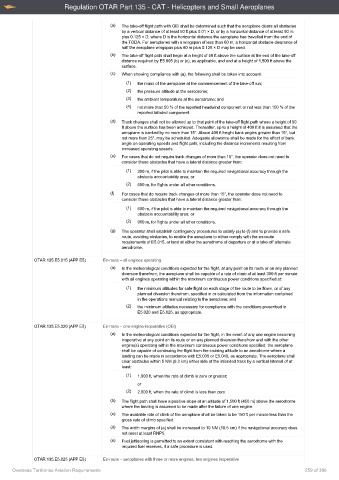Page 259 - Overseas Territories Aviation Requirements Consolidated - Total AOC
P. 259
Regulation OTAR Part 135 - CAT - Helicopters and Small Aeroplanes
(a) The take-off flight path with OEI shall be determined such that the aeroplane clears all obstacles
by a vertical distance of at least 50 ft plus 0.01 × D, or by a horizontal distance of at least 90 m
plus 0.125 × D, where D is the horizontal distance the aeroplane has travelled from the end of
the TODA. For aeroplanes with a wingspan of less than 60 m, a horizontal obstacle clearance of
half the aeroplane wingspan plus 60 m plus 0.125 × D may be used.
(b) The take-off flight path shall begin at a height of 50 ft above the surface at the end of the take-off
distance required by E5.005 (b) or (c), as applicable, and end at a height of 1,500 ft above the
surface.
(c) When showing compliance with (a), the following shall be taken into account:
(1) the mass of the aeroplane at the commencement of the take-off run;
(2) the pressure altitude at the aerodrome;
(3) the ambient temperature at the aerodrome; and
(4) not more than 50 % of the reported headwind component or not less than 150 % of the
reported tailwind component.
(d) Track changes shall not be allowed up to that point of the take-off flight path where a height of 50
ft above the surface has been achieved. Thereafter, up to a height of 400 ft it is assumed that the
aeroplane is banked by no more than 15°. Above 400 ft height bank angles greater than 15°, but
not more than 25°, may be scheduled. Adequate allowance shall be made for the effect of bank
angle on operating speeds and flight path, including the distance increments resulting from
increased operating speeds.
(e) For cases that do not require track changes of more than 15°, the operator does not need to
consider those obstacles that have a lateral distance greater than:
(1) 300 m, if the pilot is able to maintain the required navigational accuracy through the
obstacle accountability area; or
(2) 600 m, for flights under all other conditions.
(f) For cases that do require track changes of more than 15°, the operator does not need to
consider those obstacles that have a lateral distance greater than:
(1) 600 m, if the pilot is able to maintain the required navigational accuracy through the
obstacle accountability area; or
(2) 900 m, for flights under all other conditions.
(g) The operator shall establish contingency procedures to satisfy (a) to (f) and to provide a safe
route, avoiding obstacles, to enable the aeroplane to either comply with the en-route
requirements of E5.015, or land at either the aerodrome of departure or at a take-off alternate
aerodrome.
OTAR.135.E5.015 (APP E5) En-route – all engines operating
(a) In the meteorological conditions expected for the flight, at any point on its route or on any planned
diversion therefrom, the aeroplane shall be capable of a rate of climb of at least 300 ft per minute
with all engines operating within the maximum continuous power conditions specified at:
(1) the minimum altitudes for safe flight on each stage of the route to be flown, or of any
planned diversion therefrom, specified in or calculated from the information contained
in the operations manual relating to the aeroplane; and
(2) the minimum altitudes necessary for compliance with the conditions prescribed in
E5.020 and E5.025, as appropriate.
OTAR.135.E5.020 (APP E5) En-route – one-engine-inoperative (OEI)
(a) In the meteorological conditions expected for the flight, in the event of any one engine becoming
inoperative at any point on its route or on any planned diversion therefrom and with the other
engine(s) operating within the maximum continuous power conditions specified, the aeroplane
shall be capable of continuing the flight from the cruising altitude to an aerodrome where a
landing can be made in accordance with E5.035 or E5.040, as appropriate. The aeroplane shall
clear obstacles within 5 NM (9.3 km) either side of the intended track by a vertical interval of at
least:
(1) 1,000 ft, when the rate of climb is zero or greater;
or
(2) 2,000 ft, when the rate of climb is less than zero.
(b) The flight path shall have a positive slope at an altitude of 1,500 ft (450 m) above the aerodrome
where the landing is assumed to be made after the failure of one engine.
(c) The available rate of climb of the aeroplane shall be taken to be 150 ft per minute less than the
gross rate of climb specified.
(d) The width margins of (a) shall be increased to 10 NM (18.5 km) if the navigational accuracy does
not meet at least RNP5.
(e) Fuel jettisoning is permitted to an extent consistent with reaching the aerodrome with the
required fuel reserves, if a safe procedure is used.
OTAR.135.E5.025 (APP E5) En-route – aeroplanes with three or more engines, two engines inoperative
Overseas Territories Aviation Requirements 259 of 386

